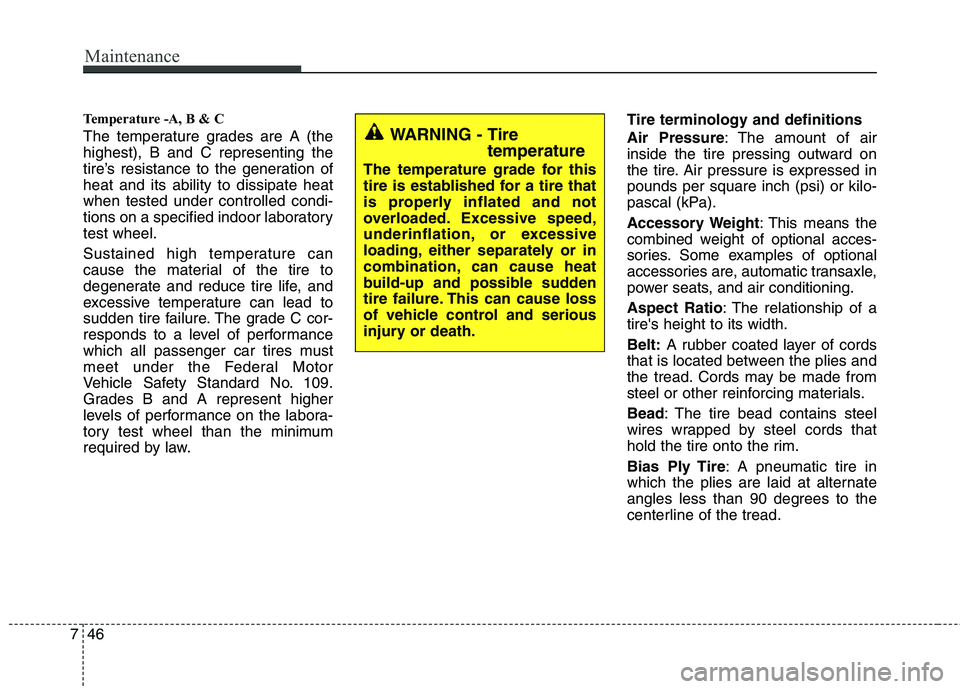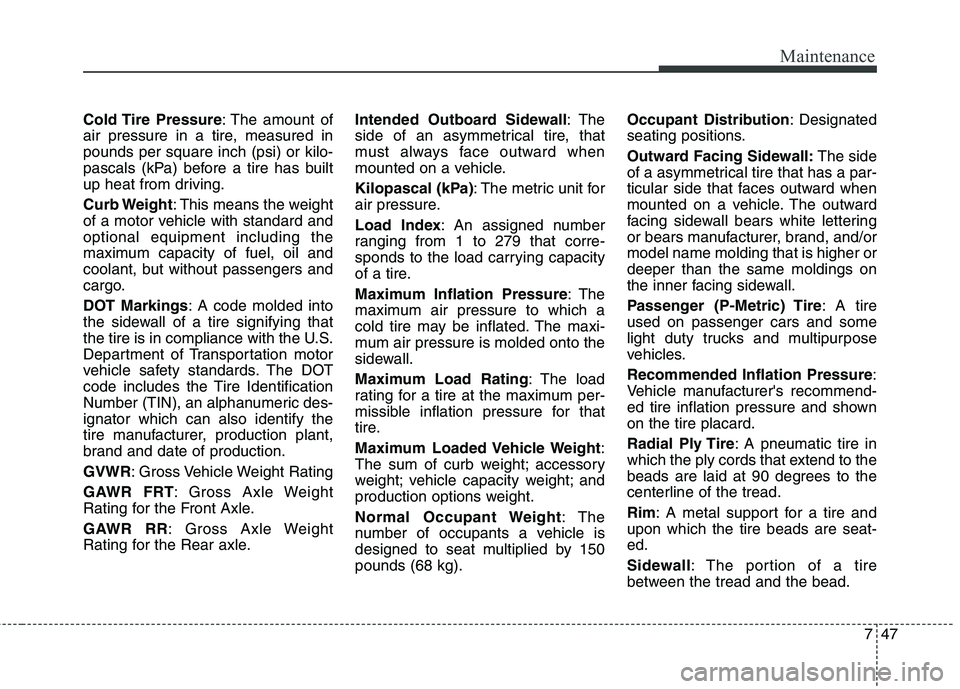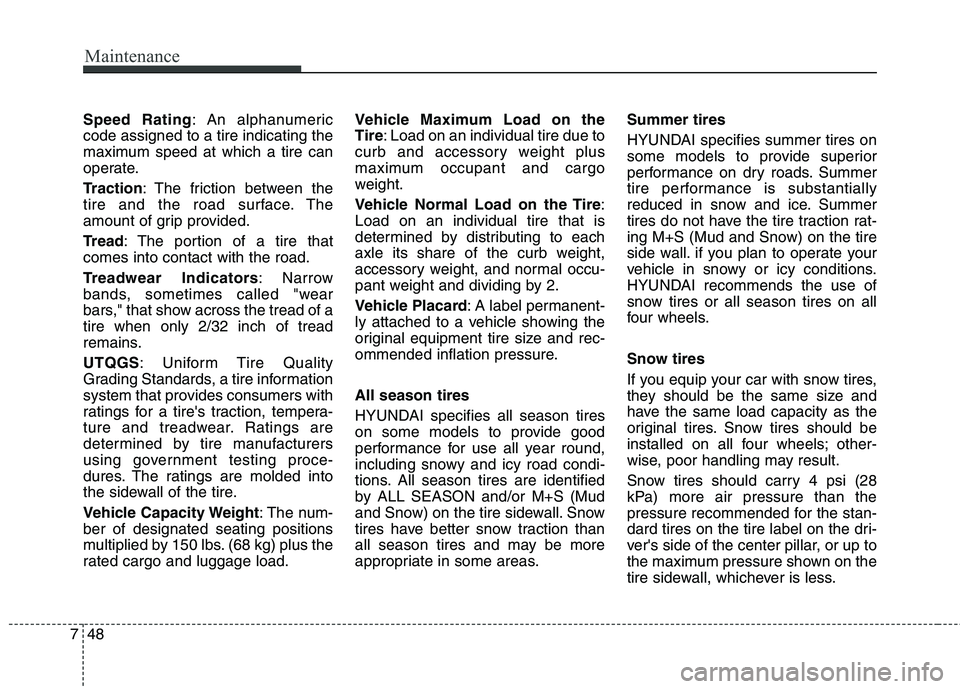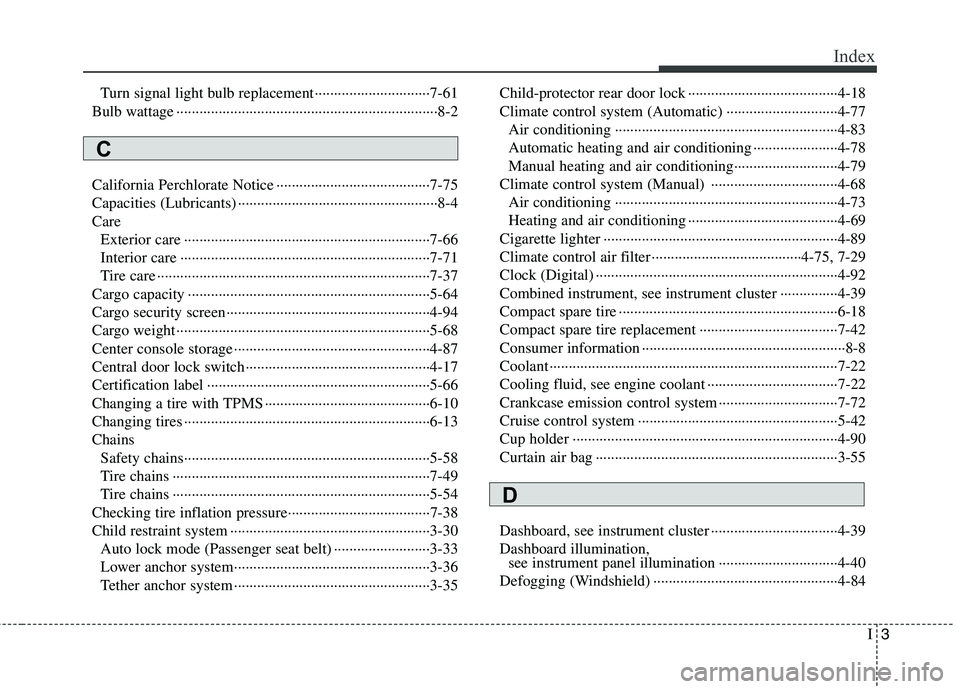weight HYUNDAI TUCSON 2013 Owner's Manual
[x] Cancel search | Manufacturer: HYUNDAI, Model Year: 2013, Model line: TUCSON, Model: HYUNDAI TUCSON 2013Pages: 397, PDF Size: 5.55 MB
Page 346 of 397

Maintenance
46
7
Temperature -A, B & C
The temperature grades are A (the highest), B and C representing the
tire’s resistance to the generation ofheat and its ability to dissipate heatwhen tested under controlled condi-
tions on a specified indoor laboratorytest wheel.
Sustained high temperature can
cause the material of the tire to
degenerate and reduce tire life, and
excessive temperature can lead to
sudden tire failure. The grade C cor-
responds to a level of performance
which all passenger car tires must
meet under the Federal Motor
Vehicle Safety Standard No. 109.
Grades B and A represent higher
levels of performance on the labora-
tory test wheel than the minimum
required by law. Tire terminology and definitions Air Pressure
: The amount of air
inside the tire pressing outward on
the tire. Air pressure is expressed inpounds per square inch (psi) or kilo-
pascal (kPa).
Accessory Weight : This means the
combined weight of optional acces-
sories. Some examples of optional
accessories are, automatic transaxle,
power seats, and air conditioning. Aspect Ratio : The relationship of a
tire's height to its width.Belt: A rubber coated layer of cords
that is located between the plies and
the tread. Cords may be made from
steel or other reinforcing materials. Bead : The tire bead contains steel
wires wrapped by steel cords that
hold the tire onto the rim.
Bias Ply Tire : A pneumatic tire in
which the plies are laid at alternate
angles less than 90 degrees to the
centerline of the tread.WARNING - Tire temperature
The temperature grade for this
tire is established for a tire that
is properly inflated and not
overloaded. Excessive speed,
underinflation, or excessive
loading, either separately or in
combination, can cause heat
build-up and possible sudden
tire failure. This can cause loss
of vehicle control and serious
injury or death.
Page 347 of 397

747
Maintenance
Cold Tire Pressure: The amount of
air pressure in a tire, measured in pounds per square inch (psi) or kilo-
pascals (kPa) before a tire has built
up heat from driving.
Curb Weight : This means the weight
of a motor vehicle with standard and optional equipment including the
maximum capacity of fuel, oil and
coolant, but without passengers and
cargo.
DOT Markings : A code molded into
the sidewall of a tire signifying that
the tire is in compliance with the U.S.
Department of Transportation motor
vehicle safety standards. The DOT
code includes the Tire Identification
Number (TIN), an alphanumeric des-ignator which can also identify the
tire manufacturer, production plant,
brand and date of production. GVWR : Gross Vehicle Weight Rating
GAWR FRT : Gross Axle Weight
Rating for the Front Axle.
GAWR RR : Gross Axle Weight
Rating for the Rear axle. Intended Outboard Sidewall
: The
side of an asymmetrical tire, that
must always face outward when
mounted on a vehicle.
Kilopascal (kPa) : The metric unit for
air pressure.
Load Index : An assigned number
ranging from 1 to 279 that corre-
sponds to the load carrying capacity
of a tire.
Maximum Inflation Pressure : The
maximum air pressure to which a
cold tire may be inflated. The maxi-
mum air pressure is molded onto the
sidewall.
Maximum Load Rating : The load
rating for a tire at the maximum per-
missible inflation pressure for that
tire.
Maximum Loaded Vehicle Weight :
The sum of curb weight; accessory
weight; vehicle capacity weight; and
production options weight.
Normal Occupant Weight :The
number of occupants a vehicle is
designed to seat multiplied by 150pounds (68 kg). Occupant Distribution
: Designated
seating positions.
Outward Facing Sidewall: The side
of a asymmetrical tire that has a par-
ticular side that faces outward when
mounted on a vehicle. The outward
facing sidewall bears white lettering
or bears manufacturer, brand, and/ormodel name molding that is higher ordeeper than the same moldings on
the inner facing sidewall.
Passenger (P-Metric) Tire : A tire
used on passenger cars and some
light duty trucks and multipurpose
vehicles. Recommended Inflation Pressure :
Vehicle manufacturer's recommend-
ed tire inflation pressure and shownon the tire placard.
Radial Ply Tire : A pneumatic tire in
which the ply cords that extend to the
beads are laid at 90 degrees to the
centerline of the tread. Rim : A metal support for a tire and
upon which the tire beads are seat- ed.
Sidewall : The portion of a tire
between the tread and the bead.
Page 348 of 397

Maintenance
48
7
Speed Rating : An alphanumeric
code assigned to a tire indicating the
maximum speed at which a tire can
operate.
Traction : The friction between the
tire and the road surface. The
amount of grip provided.
Tr e a d : The portion of a tire that
comes into contact with the road.
Treadwear Indicators : Narrow
bands, sometimes called "wear
bars," that show across the tread of atire when only 2/32 inch of tread
remains. UTQGS : Uniform Tire Quality
Grading Standards, a tire information
system that provides consumers with
ratings for a tire's traction, tempera-
ture and treadwear. Ratings are
determined by tire manufacturers
using government testing proce-
dures. The ratings are molded into
the sidewall of the tire.
Vehicle Capacity Weight : The num-
ber of designated seating positions
multiplied by 150 lbs. (68 kg) plus the
rated cargo and luggage load. Vehicle Maximum Load on theTire
: Load on an individual tire due to
curb and accessory weight plus
maximum occupant and cargo
weight.
Vehicle Normal Load on the Tire :
Load on an individual tire that is
determined by distributing to each
axle its share of the curb weight,
accessory weight, and normal occu-
pant weight and dividing by 2.
Vehicle Placard : A label permanent-
ly attached to a vehicle showing the
original equipment tire size and rec-
ommended inflation pressure. All season tires
HYUNDAI specifies all season tires
on some models to provide good
performance for use all year round,
including snowy and icy road condi-
tions. All season tires are identified
by ALL SEASON and/or M+S (Mud
and Snow) on the tire sidewall. Snow
tires have better snow traction than
all season tires and may be more
appropriate in some areas. Summer tires
HYUNDAI specifies summer tires on
some models to provide superior
performance on dry roads. Summer
tire performance is substantially
reduced in snow and ice. Summer
tires do not have the tire traction rat-
ing M+S (Mud and Snow) on the tire
side wall. if you plan to operate your
vehicle in snowy or icy conditions.
HYUNDAI recommends the use of
snow tires or all season tires on all
four wheels.
Snow tires
If you equip your car with snow tires,
they should be the same size and
have the same load capacity as the
original tires. Snow tires should be
installed on all four wheels; other-
wise, poor handling may result.
Snow tires should carry 4 psi (28
kPa) more air pressure than the
pressure recommended for the stan-
dard tires on the tire label on the dri-
ver's side of the center pillar, or up to
the maximum pressure shown on the
tire sidewall, whichever is less.
Page 387 of 397

I3
Index
Turn signal light bulb replacement······························7-61
Bulb wattage ····································································8-2
California Perchlorate Notice ········································7-75
Capacities (Lubricants) ····················································8-4Care Exterior care ································································7-66
Interior care ·································································7-71
Tire care ·······································································7-37
Cargo capacity ·······························································5-64
Cargo security screen·····················································4-94
Cargo weight ··································································5-68
Center console storage ···················································4-87
Central door lock switch················································4-17
Certification label ··························································5-66
Changing a tire with TPMS ···········································6-10
Changing tires ································································6-13Chains Safety chains································································5-58
Tire chains ···································································7-49
Tire chains ···································································5-54
Checking tire inflation pressure·····································7-38
Child restraint system ····················································3-30 Auto lock mode (Passenger seat belt) ·························3-33
Lower anchor system···················································3-36
Tether anchor system ···················································3-35 Child-protector rear door lock ·······································4-18
Climate control system (Automatic) ·····························4-77
Air conditioning ··························································4-83
Automatic heating and air conditioning ······················4-78
Manual heating and air conditioning···························4-79
Climate control system (Manual) ·································4-68 Air conditioning ··························································4-73
Heating and air conditioning ·······································4-69
Cigarette lighter ·····························································4-89
Climate control air filter ·······································4-75, 7-29
Clock (Digital) ·······························································4-92
Combined instrument, see instrument cluster ···············4-39
Compact spare tire ·························································6-18
Compact spare tire replacement ····································7-42
Consumer information ·····················································8-8
Coolant ···········································································7-22
Cooling fluid, see engine coolant ··································7-22
Crankcase emission control system ·······························7-72
Cruise control system ····················································5-42
Cup holder ·····································································4-90
Curtain air bag ·······························································3-55
Dashboard, see instrument cluster ·································4-39 Dashboard illumination, see instrument panel illumination ·······························4-40
Defogging (Windshield) ················································4-84
C
D
Page 394 of 397

Index
10I
Tie-down hook (for flatbed towing) ····························6-24
Towing capacity ·····························································5-64
Trailer towing·································································5-57 Hitches ·········································································5-58
Safety chains································································5-58
Trailer brakes ·······························································5-58
Weight of the trailer (tongue) ······································5-63
Transaxle Automatic transaxle ·····················································5-16
Manual transaxle ·························································5-13
Tripmeter········································································4-43
Trip computer ································································4-42
Turn signal light bulb replacement ································7-61
Vehicle break-in process ··················································1-5
Vehicle certification label ················································8-6
Vehicle data collection and event data recorders·············1-6
Vehicle identification number (VIN) ·······························8-6
Vehicle load limit ···························································5-64 Cargo capacity ·····························································5-64
Certification label ························································5-66
Seating capacity ···························································5-64
Tire and loading information label ······························5-64
Towing capacity···························································5-64
Vehicle capacity weight ···············································5-64
Vehicle stability management (VSM) ···························5-38 Vehicle weight ·······························································5-68
Base curb weight ·························································5-68
Cargo weight ·······························································5-68
GAW (Gross axle weight) ···········································5-68
GAWR (Gross axle weight rating) ······························5-68
GVW (Gross vehicle weight) ······································5-68
GVWR (Gross vehicle weight rating) ·························5-68
Washer fluid ···································································7-26
Waste tray, see ashtray ···················································4-89
Warnings and indicators ················································4-45
Weight ············································································5-68 Base curb weight ·························································5-68
Cargo weight ·······························································5-68
GAW (Gross axle weight) ···········································5-68
GAWR (Gross axle weight rating) ······························5-68
GVW (Gross vehicle weight) ······································5-68
GVWR (Gross vehicle weight rating) ·························5-68
Wheel alignment and tire balance ·································7-40
Wheel replacement ························································7-42
Windows ········································································4-21 Auto up/down window ················································4-23
Power window lock button ··········································4-24
Windshield defrosting and defogging····························4-84 Defogging logic ···························································4-86
V
W